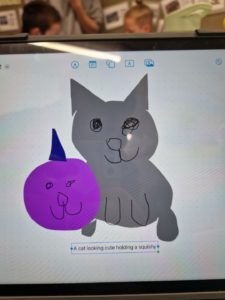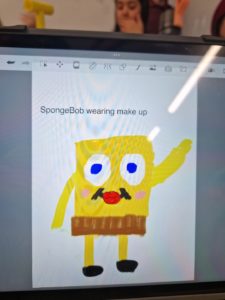Drawing with AI at Cramond Primary
By Valentina Andries
This month we ran a workshop with a primary 5 class (ages 9-10) in a state-funded school in Edinburgh. We worked with the class teacher and Informatics students from the University of Edinburgh (Gareth Dawson, Jatin Soni, Leo Kravtchin and Scott Adamson), who shared their knowledge of Artificial Intelligence (AI) with young learners.
We presented three main activities, each targeting different aspects related to AI. All the activities included a practical component and real-world examples of AI applications, services or tools that use AI technology, to facilitate children’s understanding of these otherwise rather abstract concepts (or so-called ‘black-box’ technology).
The workshop started with an ‘unplugged’ activity without using technology, aimed at fostering children’s understanding of how smart speakers (like Amazon’s Alexa, or Google Home) work. Gareth assigned roles to the children which corresponded to the key features of smart speakers such as the microphone, processor, or Amazon database. This exercise was iterated a few times, with different volunteers, giving different children in the class a chance to participate. The children could act out previously-scripted interactions, which echoed their primary use of smart speakers (according to our study findings and OfCom report), such as playing music, asking facts, or asking for jokes. But they also got a chance to ask impromptu questions of their own, giving the ‘actors’ further opportunities to show their understanding of how smart speakers work. Gareth presented a brief slide-show of what happens when a user asks Alexa a question, showing how that request is sent to the Amazon servers, to reinforce the main concepts targeted via the unplugged activity.
The children were very engaged during the exercise, and were full of questions about smart speakers, some of which tapped into wider discussions about AI intelligence or sentience.
Next up was a session on Machine Learning (ML) ran by Jatin Soni. This began with a brief slide-show introduction to what ML means, how ML systems work, and examples of technology that make use of ML approaches. For this activity, the children filled in Bingo cards which showed real-world examples of ML-supported technologies or services (e.g. using FaceID to unlock a phone, watch recommended videos on YouTube). Pairs of children were asked to tick off the examples that they had encountered in their daily life. Jatin and Valentina went round to check on the children’s selections and facilitate discussion on ML concepts. This activity was followed by discussion with the whole class, giving the children the opportunity to ask questions. Jatin clarified that all the examples provided on the Bingo sheet were instances of machine learning. Some children made references to Alexa, so Jatin reinforced the link between smart speakers and ML, as technology like Alexa uses ML to work.
For the final session, led by Leo Kravtchin and Scott Adamson, the children were excited to use their iPads in a creative exercise with AI. This activity was aimed at reinforcing concepts such as the amount of data and types of data that are needed for systems to make more accurate predictions, by using drawing applications of AI and engaging the children in a creative exercise. The children loved using Dream AI to transform their sketches into weird and wonderful digital artworks.


‘A cat looking cute holding a squishy’


‘SpongBob wearing make up’
The children were asked to give a star-rating to questions asking about their previous familiarity with the topics covered during the day, whether their understanding of those concepts improved that day, and if they would like to know more about smart speaker technology, ML and AI respectively. Most of the children said that they would like to know more about smart speakers (26 out of 32), about machine learning (24 out of 32 children), and about AI (25 out of 30). The majority of the children responded positively to the questions, further reinforcing the overall positive response and engagement that they displayed while involved in the sessions:
“I loved how it changed my terrible drawing into an amazing drawing”
“I liked the Alexa activity, seeing how AI turns drawings amazing and playing bingo”
Find out more
Children and parents: media use and attitudes report 2022 – Ofcom



